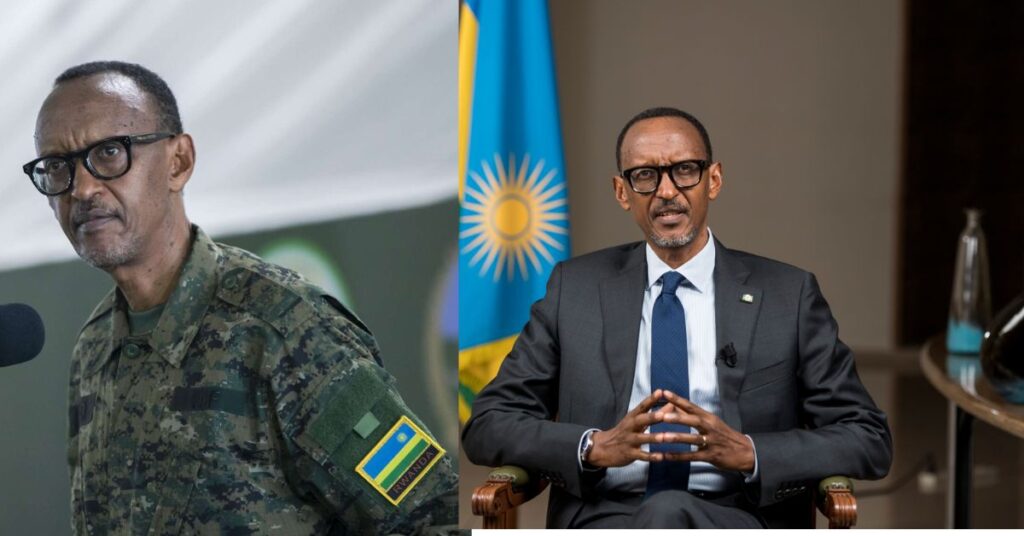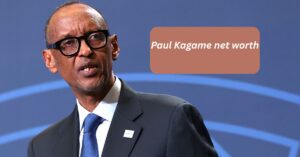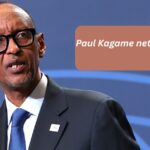Paul Kagame is the President of Rwanda. He became President in 2000 after many years of leadership. Kagame is known for ending the Rwandan genocide. Today, he is one of Africa’s most powerful leaders.
Many people are curious about Kagame’s life. How did he become so rich and famous? What is his real story behind the headlines? Let’s dive into the journey of this strong and important leader.
Paul Kagame net worth is around $510 million. He made his fortune through smart investments and business deals. Kagame also owns a private jet and many businesses. His financial power is huge in Rwanda and beyond.
Who is Paul Kagame?
Paul Kagame is a Rwandan politician and former military leader. He has been the President of Rwanda since 2000. Kagame is known for helping end the Rwandan genocide and rebuilding the country. Today, he is seen as one of Africa’s most influential and powerful leaders.
Profile Summary
| Attribute | Details |
| Full Name | Paul Kagame |
| Date of Birth | October 23, 1957 |
| Place of Birth | Tambwe, Ruanda-Urundi (now part of Rwanda) |
| Position | President of Rwanda |
| Term as President | 2000 – Present |
| Height | 6 feet 2 inches (188 cm) |
| Net Worth | $510 million (estimated) |
| Sources of Wealth | Political leadership, investments, diamond trading, Crystal Ventures |
| Political Party | Rwandan Patriotic Front (RPF) |
| Spouse | Jeannette Nyiramongi Kagame |
| Children | Four children |
| Military Role | Former commander of the Rwandan Patriotic Front (RPF) |
| Leadership Impact | Economic growth, regional stability, technological innovation, gender equality initiatives |
| Awards & Honors | Several international awards and recognitions for leadership, peace, and development |
| Controversies | Criticized for political opposition suppression and human rights concerns |
| Vision | Vision 2020 & Vision 2050 plans for Rwanda’s continued growth and modernization |
Paul Kagame’s Early Life and Background
Paul Kagame was born in October 1957 in Tambwe, Ruanda-Urundi, a region under Belgian control at the time. When he was just two years old, his family fled to Uganda to escape ethnic violence against the Tutsi population. Growing up in refugee camps, Kagame experienced hardship, poverty, and life without a permanent home. These early struggles had a deep impact on his character.
In Uganda, Kagame pursued his education while living among fellow Rwandan refugees. He later became involved in military training and political movements. His experiences as a refugee fueled his desire to fight for justice and reclaim his homeland.
Rise to Power: Paul Kagame’s Military and Political Journey
Kagame’s military career began when he joined the Ugandan army, gaining experience and leadership skills. In 1990, he became a founding member of the Rwandan Patriotic Front (RPF), a group of exiled Rwandans who aimed to overthrow the Rwandan government.
After the death of the RPF’s leader, Fred Rwigyema, Kagame assumed command. Under his leadership, the RPF became a powerful force and played a significant role in ending the Rwandan genocide.
His role in the Rwandan Patriotic Front (RPF)
Paul Kagame played a pivotal role in the formation and leadership of the Rwandan Patriotic Front (RPF), a rebel group initially created by Rwandan exiles in Uganda. In 1990, the RPF launched an invasion into Rwanda, with Kagame leading many of the military operations. Having been trained in the Ugandan army, Kagame quickly emerged as a key military strategist and leader. His leadership was essential in directing the RPF forces against the Rwandan government, which was responsible for the escalating ethnic violence.
Kagame’s role in the RPF became even more significant after the death of Fred Rwigyema, the RPF’s founder, in 1990. Kagame assumed command and led the group to victory in the Rwandan Civil War. His military leadership helped end the 1994 genocide, as the RPF’s intervention ultimately stopped the massacre of the Tutsi population. Kagame’s decisive actions as a commander earned him national recognition, setting the stage for his rise to political power in post-genocide Rwanda.
Ending the Rwandan Genocide
The Rwandan genocide, which took place in 1994, saw the mass slaughter of Tutsis and moderate Hutus by extremist Hutus. Paul Kagame and the Rwandan Patriotic Front (RPF) played a crucial role in ending the genocide. As the leader of the RPF, Kagame directed military operations to stop the mass killings. The RPF’s advance into Rwanda effectively halted the genocide, saving thousands of lives. Kagame’s forces were instrumental in defeating the genocidal regime, which was responsible for the atrocities.
Kagame’s leadership during this period is often hailed as a turning point in Rwanda’s history. While the international community failed to intervene, Kagame’s military strategy not only stopped the genocide but also paved the way for the reconstruction of Rwanda. Under his command, the RPF restored order and helped establish a new government, focused on healing and rebuilding the war-torn nation. His decisive actions in the face of overwhelming violence cemented his legacy as a key figure in Rwanda’s recovery.
Also Read: Emily Ha Age, Height, Weight, Career, Net Worth And Full Bio
Becoming Vice President and later President
After the genocide in 1994, Paul Kagame emerged as Rwanda’s de facto leader. Following the defeat of the genocidal regime, the country was in ruins, and a new government was needed. Kagame was appointed Vice President and Minister of Defence in the transitional government. During this time, he was effectively in control of the country, overseeing the rebuilding process. His leadership was instrumental in restoring order, establishing peace, and beginning the difficult task of national reconciliation.
In 2000, Kagame officially became the President of Rwanda after the resignation of President Pasteur Bizimungu. His leadership was marked by a commitment to stability, economic growth, and national unity. Kagame won the presidential election in 2003, after a new constitution was adopted, and he was re-elected for a second term in 2010. Kagame’s presidency brought about significant improvements in Rwanda’s infrastructure, healthcare, and education systems, earning him both national and international acclaim for transforming Rwanda from a country devastated by genocide to one of Africa’s fastest-growing economies.
How Much is Paul Kagame’s Net Worth?
Current estimated net worth ($510 million)
Paul Kagame, the President of Rwanda, is estimated to have a net worth of approximately $510 million. His wealth primarily stems from strategic investments in various industries, including diamond trading and significant stakes in major Rwandan companies. Notably, Kagame and his family are reported to control the majority of the Rwandan economy through a holding company known as Crystal Ventures .
Sources of wealth: diamond trading, investments, Crystal Ventures
Crystal Ventures is a prominent investment firm in Rwanda, with interests spanning construction, real estate, telecommunications, and other sectors. In 2012, the Financial Times reported that Crystal Ventures owned assets valued at $500 million, including a $50 million Bombardier Global Express private jet .
These investments have significantly contributed to Kagame’s financial standing and influence within Rwanda and beyond.
Paul Kagame’s Salary as President of Rwanda
Paul Kagame, President of Rwanda, receives an annual salary of $85,000, as stipulated by the Rwandan government’s Presidential Order No. 004/01 of 16/02/2017, which outlines compensation for high-ranking state officials . This translates to approximately $7,083.33 per month, $1,634.62 per week, and $326.92 per day.
In addition to his salary, Kagame is entitled to several benefits, including a fully furnished residential house, five official vehicles with maintenance costs covered by the state, an office entertainment allowance, modern communication equipment, and a monthly residence and guest entertainment allowance of Rwf 6,500,000 (approximately $6,500). Household expenses, such as water and electricity, are also covered by the state, and he receives continuous security at work, home, and any other place as deemed necessary.
It’s important to note that while Kagame’s official salary is publicly disclosed, his overall net worth is primarily driven by his various investments and business ventures outside of his official salary .
Must Read: Jynxzi Net Worth 2025: How the Twitch Star Built a $5 Million Empire
Business Empire: Kagame’s Investments and Crystal Ventures
Crystal Ventures assets and influence on Rwanda’s economy
Established in 1995 as Tri-Star Investments and rebranded to Crystal Ventures Ltd in 2009, CVL is the investment arm of the Rwandan Patriotic Front (RPF), the ruling political party led by President Paul Kagame. The conglomerate has become a dominant force in Rwanda’s economy, with assets estimated at $500 million. CVL operates in diverse sectors including construction, telecommunications, agriculture, and security services, making it one of the country’s largest private employers.
CVL’s influence extends beyond Rwanda’s borders, with recent expansions into international markets. In Mozambique, CVL’s subsidiary, ISCO Segurança, secured a security contract for TotalEnergies’ $20 billion liquefied natural gas project, highlighting the conglomerate’s growing international presence . This expansion is part of Rwanda’s broader economic diplomacy efforts, positioning CVL as a key player in regional economic development.
Private jet and other known holdings
President Kagame’s use of a Gulfstream G650ER private jet, chartered from CVL, has been a subject of scrutiny. The aircraft, valued at approximately $66 million, is utilized for official state visits and international engagements . The cost of chartering such a jet is estimated at $6,400 per hour, raising questions about the allocation of public funds, especially in a country where a significant portion of government expenditure is supported by foreign aid.
Critics argue that the chartering of the jet from a company owned by the ruling party creates a conflict of interest and lacks transparency. Despite these concerns, the arrangement continues, reflecting the intertwined nature of Rwanda’s political leadership and its business ventures. Supporters contend that the use of the jet is justified by the need for efficient diplomatic engagement and the promotion of Rwanda’s interests on the global stage.
Paul Kagame’s Leadership and Rwanda’s Economic Transformation
Paul Kagame’s leadership has been pivotal in transforming Rwanda from a war-torn country into one of Africa’s fastest-growing economies. After the 1994 genocide, Kagame’s government focused on reconciliation, good governance, and economic development. His emphasis on infrastructure, healthcare, and education has helped reshape Rwanda into a regional hub for business and innovation.
Under Kagame, Rwanda has experienced significant economic growth, with its GDP increasing steadily over the years. His government implemented policies to attract foreign investment, improve the business environment, and promote entrepreneurship. These efforts have made Rwanda a model of economic progress in Africa, with notable improvements in sectors like tourism, agriculture, and technology.
How his leadership impacted Rwanda’s economy
Paul Kagame’s leadership has greatly helped Rwanda’s economy grow. After the genocide, he focused on rebuilding the country, improving health, education, and infrastructure. His government worked hard to create jobs and support businesses, making it easier for people to start their own companies.
Thanks to Kagame’s efforts, Rwanda became a popular place for foreign businesses to invest. The country’s economy grew fast, and many people’s lives improved. Agriculture, tourism, and technology are some of the areas that saw big progress, helping Rwanda become one of Africa’s fastest-growing economies.
Vision 2020 and Vision 2050 plans
Vision 2020 was Paul Kagame’s plan to transform Rwanda into a middle-income country by the year 2020. The goal was to reduce poverty, improve education and healthcare, and grow the economy. Kagame’s government worked to improve infrastructure, attract foreign investments, and promote technology. By focusing on these areas, Rwanda aimed to become a strong, self-sufficient nation.
After achieving many of the goals of Vision 2020, Rwanda introduced Vision 2050. This plan aims to make Rwanda an upper-middle-income country with a strong, diversified economy. Vision 2050 focuses on further developing industries like technology, manufacturing, and services. It also emphasizes environmental sustainability and building a skilled workforce to ensure long-term prosperity.
Controversies and Criticism
Paul Kagame’s leadership, while praised for Rwanda’s economic growth, has also faced significant criticism. One of the main concerns is the suppression of political opposition. Critics argue that Kagame’s government restricts free speech, and political opponents are often silenced through intimidation, imprisonment, or exile. This has led to accusations of authoritarian rule, with little room for political competition.
Human rights organizations have raised concerns over Kagame’s government’s treatment of its citizens. There are reports of restrictions on freedom of the press, assembly, and expression. Additionally, international critics point to the government’s role in conflicts in neighboring countries, such as the Democratic Republic of Congo, as a source of tension. Despite this, Kagame maintains strong support within Rwanda for his leadership and economic achievements.
Paul Kagame’s Personal Life: Family, Wife, and Children

Paul Kagame, the President of Rwanda, leads a closely-knit family that plays a significant role in both his personal life and public image. He is married to Jeannette Nyiramongi Kagame, whom he wed in 1989. Born on August 10, 1962, in Burundi, Jeannette became Rwanda’s First Lady in 2000 when Paul assumed the presidency. She is the founder and chairperson of the Imbuto Foundation, a non-profit organization dedicated to supporting the development of a healthy, educated, and prosperous society .
Together, Paul and Jeannette have four children: Ivan, Ange, Ian, and Brian. Their daughter, Ange Kagame, is notably active in humanitarian efforts and has been involved in various initiatives aimed at empowering women and youth in Rwanda . The Kagame family maintains a relatively private life, with occasional public appearances that highlight their commitment to Rwanda’s development and social welfare.
In addition to their immediate family, Paul and Jeannette have celebrated the arrival of grandchildren, marking significant personal milestones. For instance, in 2021, they welcomed a second grandchild, bringing joy to their family circle . These family events are cherished moments for the Kagame family, reflecting their close bonds and shared values.
How Tall is Paul Kagame?
Height: 6ft 2in (188 cm)
Paul Kagame stands tall at 6 feet 2 inches (188 cm), making him noticeably taller than many of his peers. His height, combined with his commanding presence, often adds to his authoritative image as Rwanda’s leader.
Public impressions of his appearance
Public impressions of Kagame’s appearance have been mixed. Some have noted his slim build, which contrasts with his strong and assertive leadership style. A New York Times journalist once described him as “almost sick-looking,” with “bony shoulders and delicate wrists.”
Despite this, Kagame’s physical stature and poised demeanor align with his reputation as a focused and disciplined leader on the global stage.
Awards, Honors, and Global Recognition
Honors from foreign governments
Paul Kagame has received numerous awards and honors from foreign governments, recognizing his leadership and Rwanda’s progress. For instance, he has been awarded the Order of the Leopard by the Democratic Republic of Congo, acknowledging his role in improving regional stability. Kagame has also received honors from countries such as China, India, and France, commending his contributions to economic development, peace-building, and diplomacy in Africa.
Global leadership praise
Globally, Kagame is often praised for his role in transforming Rwanda from a devastated country into an economic powerhouse. He has earned accolades for his strong leadership, particularly in fostering growth, promoting technology, and focusing on women’s empowerment. Kagame’s achievements have earned him recognition as one of Africa’s most influential leaders, frequently ranking among the top global figures in leadership and governance.
Must Read: Jynxzi Net Worth 2025: How the Twitch Star Built a $5 Million Empire
Interesting Facts About Paul Kagame
Paul Kagame is a fascinating leader with a rich history and unique qualities. Here are some interesting facts about him:
- Military Background: Before becoming Rwanda’s president, Kagame was a key figure in the Rwandan Patriotic Front (RPF), playing a critical role in ending the 1994 genocide. He served as the RPF’s military leader, leading the rebellion that eventually brought peace to the country.
- Tech-Savvy Leader: Kagame is a strong advocate for technology and innovation. Under his leadership, Rwanda has become a hub for tech startups and digital innovation in Africa, with initiatives aimed at turning Rwanda into a “Silicon Valley” of the continent.
- Visionary for Women’s Rights: Kagame is recognized for his commitment to gender equality. Rwanda leads the world in female representation in parliament, with women holding over 60% of the seats, largely due to Kagame’s policies supporting women’s empowerment.
- A Personal Love for Sports: Kagame has a deep interest in sports, particularly soccer. He is a passionate fan of football and has played a key role in promoting the sport in Rwanda, even supporting the creation of new sports infrastructures in the country.
- World’s Tallest African Leader: Standing at 6 feet 2 inches (188 cm), Kagame is one of the tallest African leaders. His stature, combined with his leadership, gives him a strong, commanding presence on the global stage.
Conclusion: Paul Kagame’s Legacy and Impact
Paul Kagame’s legacy is one of transformation, resilience, and bold leadership. Under his guidance, Rwanda has risen from the ashes of genocide to become one of Africa’s most stable and economically vibrant nations. Kagame’s vision for a united, prosperous Rwanda has driven remarkable strides in sectors like technology, education, and gender equality, positioning the country as a beacon of hope and progress in Africa.
However, his leadership is not without controversy. While praised for economic growth, Kagame’s government has faced criticism over human rights and political opposition suppression. Despite these challenges, Kagame’s impact on Rwanda’s development and his influence on global governance cannot be denied. His legacy will continue to shape Rwanda’s future and inspire leaders around the world.
Frequently Asked Questions
Was Paul Kagame a military officer?
Yes, Paul Kagame was a military officer and led the Rwandan Patriotic Front (RPF) during the 1990s.
Who is the wife of Paul Kagame?
Paul Kagame’s wife is Jeannette Nyiramongi Kagame, a prominent figure involved in social initiatives and Rwanda’s development.
Does Rwanda have a Vice President?
Yes, Rwanda has a Vice President who assists the President and represents Rwanda in official functions and policy matters.
When did Kagame become President?
Paul Kagame became President of Rwanda in 2000 after the resignation of former President Pasteur Bizimungu.
Related Article: Click Here











